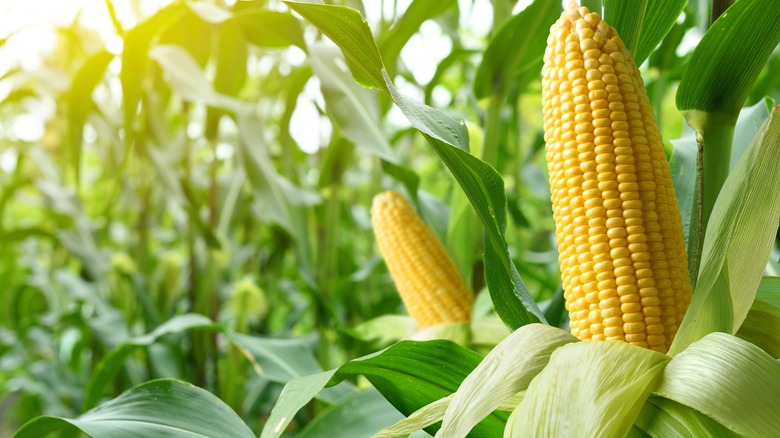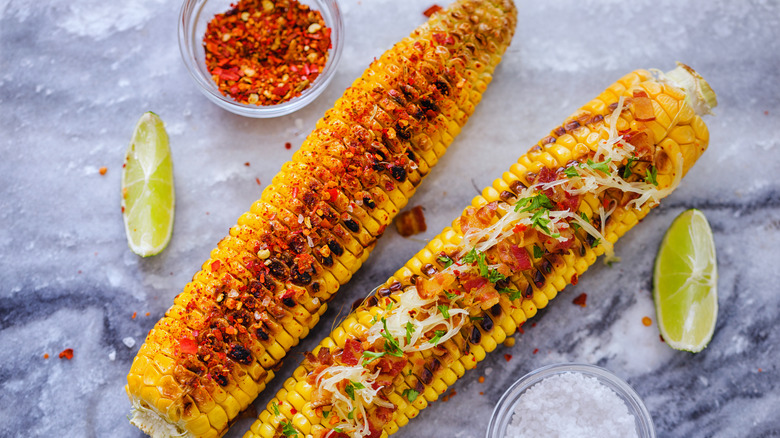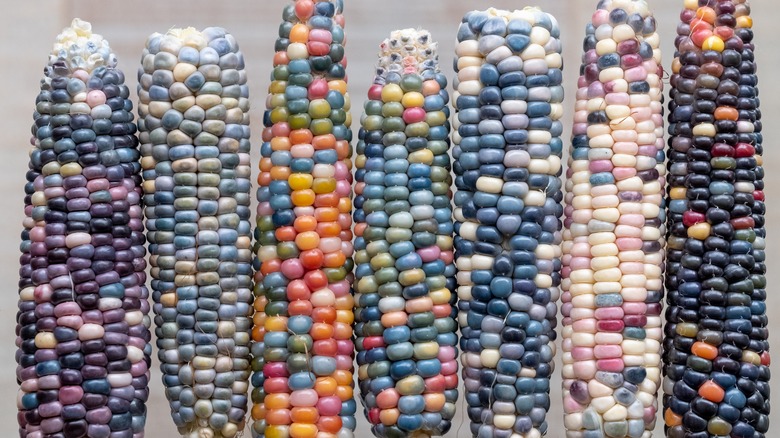Corn Is A Fruit. But It's Also A Grain And A Vegetable.
It's corn — the beloved muse of viral songs and backyard barbecues alike! There are tons of varieties and preparations, and it makes appearances in everything from summer succotash to sour candy (not to mention fuel and animal feed), but what is corn really? It turns out that corn can be classified as a fruit, a grain, or a vegetable.
Botanists classify corn, scientifically known as Zea mays, as a fruit belonging to the Poaceae family. While corn does not share many commonalities with other fruits, dietarily speaking, it still technically falls into the category because the kernels are "the fleshy or dry ripened ovary of a flowering plant, enclosing the seed or seeds" (via Britannica). Corn belongs to the club of less obvious fruits like peas, cucumbers, tomatoes, squash, okra, peppers, and eggplant.
Practically, however, corn is commonly eaten in both vegetable and grain forms. Depending on when it is harvested — and what type it is — determines the category. Corn meant for consumption on the cob, frozen, or canned is harvested while the kernels are still tender and is considered a starchy vegetable (per the USDA). Mature and dry corn is categorized as a grain.
Corn – the vegetable
There is not a strict botanical definition of vegetables, but generally, they are the edible roots, stems, flowers, or leaves of a plant and do not contain seeds. For example, a carrot is a root, celery is a stem, broccoli is a flower, and kale is a leaf. In a nutshell, any part of the plant that isn't fruit is classified as a vegetable. However, because of how fresh corn is eaten, it is dietarily considered a starchy vegetable, like potatoes, peas, sweet potatoes, and beets.
Young sweet corn holds milky liquid in its kernels, the delightful juiciness that makes eating corn on the cob so fun. Common standard corn varieties include Silver Queen, Jubilee, and Butter and Sugar. There are also sugary enhanced corn varieties like Kandy Korn and Peaches and Cream, and supersweet corn like King Kool and Early Xtra Sweet that are the sweetest of the bunch. Very young corn can be eaten whole, cob and all, and is marketed as baby corn. Because it is harvested so early, any variety of corn, including the varieties meant for plastic-like products, oils, and ethanol, can yield tasty baby corn.
Corn – the grain
Technically, corn is a caryopsis. These single-seeded dry fruits appear in grasses and are otherwise referred to as grains. Yes, many grains are fruits like rice and wheat, for example. In these plants, the seed and the fruit are tightly bound and require special processes to separate the two. White or yellow popcorn, just like brown rice, is considered a whole grain because the bran, germ, and endosperm all remain intact.
Both dent corn and flint corn are grown with the intention of reaching full maturity and drying out. Dent corn, characterized by the dimple in every kernel, is high in starch and low in sugar. It is primarily used for commercial biofuel, livestock feed, and sweeteners like the ever-pervasive high fructose corn syrup, but can also be milled to make other cornmeal or corn oil-based consumable products. Flint corn is known for coming in a range of stunning colors and is often used for fall decorations. Heirloom varieties of flint corn were grown by indigenous people and continue to be cultivated today to make cornmeal, corn flour, masa, hominy, and the like. Whether fresh, milled, popped, or pressed into a homemade tortilla, corn remains a triple threat when it comes to versatility and taste.



